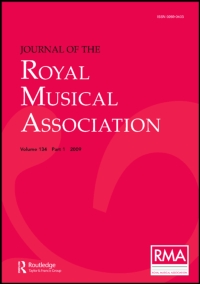Article contents
The Four Parent Scales of Modal Music
Published online by Cambridge University Press: 01 January 2020
Extract
On the philosophical side all that I need do is to enter a protest against the prevailing materialism. The earth life is a school. Its first lesson is to draw inferences from the known to the unknown. That way lie faith, imagination and truth. There are three necessary inferences. One is bound to draw them in order to live one's life as it should be lived. They lead, when followed to a logical conclusion, to a belief in three worlds instead of one. These worlds are the world of the body, the world of the sentient soul, and the world of the spirit. As a working hypothesis one may assume that there are three atomic systems in the ether, and that when they are brought together and material from them grows up so as to function as one individual, there is life. The art of music has its roots in mind or spirit. Its basis is intonation, and intonation, like creation itself, comes from the science of numbers. The musician who scorns what he calls mathematics and acoustics and prefers to follow the dictates of his own sentient soul, is likely to be the slave of his environment. He should look higher and learn the properties of numbers as applied to vibrations and the interference of vibrations. He will find that music depends on the contrast between beats or interference and no-beats or consonance. Without heeding that contrast his instrument cannot be tuned. And that contrast is presumably the same in all the worlds of existence.
- Type
- Research Article
- Information
- Copyright
- Copyright © Royal Musical Association, 1935
References
1 See Glossary.Google Scholar
2 Inadvertently a hexatonic a mode tune was used for the last two. There is no good pentatonic melody in the a mode.Google Scholar
3 A scale has seven fifths, one diminished, one false, five true. The common chord requires a true fifth.Google Scholar
4 In their first inversion they may be compared respectively with (1) milk and water, (2) tea.Google Scholar
5 Intonation is “picked up” in Europe by many; but scales are not differentiated and there is no theory.Google Scholar
6 The only object of the Ab twitch is to regularise the flat side chromatic chords of the flat keys, D♭, E♭, A♭, B♭ by providing the chords IIb, iv(b), VIb in correct intonation. Mere substitutes for these chords can be had from the C keyboard.Google Scholar
7 Bars 9 to 12.Google Scholar
8 Church choirs, by singing in veiled notes, reduce their upper partials to a minimum, making the beats of the quintal less prominent.Google Scholar
9 Musical Times, vol. 76 (1935), p. 786, 840, 927, 1018, 1022.Google Scholar
- 2
- Cited by


